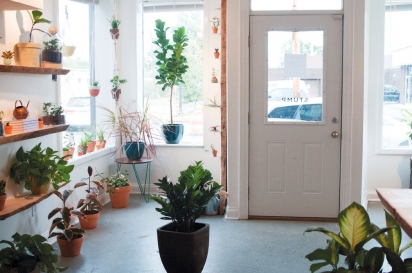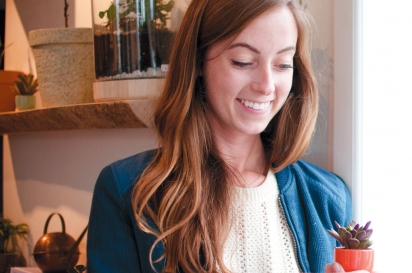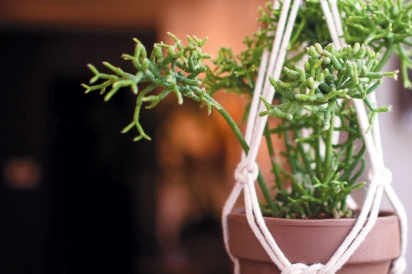Stump: Re-Inventing the Indoor, City Garden with House Plants
On either side of the reclaimed wood bar, a thick, center-cut length of ash, Brian Kellett and Emily Brown retrace their path to STUMP. The bar top has a handsome grain, its striations finished smooth. Brian runs his fingers along the grooves of the wood’s live edge, which reveals intricate tunnels dug by ash borer, a burrowing insect.
“I’ll start with where we met,” Emily says, her gaze meeting Brian’s.
Late afternoon sunlight coats a menagerie of plants perched on windowsills and tiered shelves. Wispy air plants and a towering fiddlehead fern soak it in amongst the others, including a few glossy zeezee and “snake plants,”‘ with their dappled, spear-like leaves.
STUMP offers a nontraditional retail environment for house plants tailored to urban dwellers. The selection is refined and hand-selected, each plant prepotted and priced according to size and vessel. And the educational component is fundamental. Visitors are guided toward plants that best suit their lifestyles, then equipped with information that will keep the plant flourishing.
“I found out that Brian made furniture and, at the time, I was really into furniture design. I had never actually built anything but I was considering going down that path. And eventually, I told him, I wanted to open my own business,” she says.
Soon after they started dating, Emily began an intensive design research project with AmericanHort, a nonprofit trade organization for the horticulture industry, based in Columbus. Emily traveled to garden centers across the country, learning from owners, employees, and customers about why the industry struggled to attract younger generations.
“After all these trips I would come back and talk to Brian about all the findings, all the insights we found,” she says. “It was so obvious and I think we both had a picture in our minds of what needed to happen for an urban garden center to get millennials excited about plants.”
Brian didn’t need convincing. “I always had plants in my house,” he says. “There’s something nice about seeing a space change, evolve, and grow.”
Brian began working for Rockmill Brewery in 2010, designing their website and generating social media. In 2011, Rockmill founder Matthew Barbee asked Brian if he and his father, also a skilled woodworker, could build a custom bar for their taproom.
So they did. That bar led to a table. A table to stools. Brian designed almost every label Rockmill has used on its beers. And, along the way, he taught photography in increasing capacities.
But last Thanksgiving, Brian had a dream that sealed their fate. “He woke up in the morning and said, ‘I have an idea,’” Emily recalls.
“So,” Brian says, “we started creating the brand.”
STUMP is anchored centrally by the bar, a single piece of wood Brian salvaged from a friend’s garage, mounted atop a 10-foot-by-three-foot foot light table, which casts a soft glow through custom art work. “We’ll swap the image out over the seasons,” Brian says. Over the holidays, they’ll launch a campaign to decorate house plants—a greener alterative to short-lived Christmas trees.
Once a month STUMP will collaborate with rotating artists-in-residence, featuring work from a visiting artist who will create unique materials for the shop, like hand-thrown ceramics or blown glass. For this reason Emily and Brian opted to rent the second floor of the shop, a finished apartment. “Some of our artists will have the option of staying upstairs, fortunately,” Brian says. So far, roughly a dozen artists have reached out, expressing interest in working together.
In a room just off STUMP’s entry is Flatfoot Vintage, a collection of vintage clothes, art, accessories, and housewares curated by Larry Robertson, who previously operated Brigade and Co-op in the Short North. “We met Larry and his frequency and ours were perfect,” Brian says. “We knew we could fill the space but we’re open to collaboration and totally believe in that.”
Emily gestures to the arrangement of plants against the wall behind the bar. Plants are arranged in a four-square grid. Each square reveals the ideal plant for low- or full-light settings, and frequent or more occasional watering.
Pick a plant based on your lifestyle and desired attention level, or Emily and Brian will help find a match.
Then there are custom care cards, filled out with instructions for long-term maintenance at home. “On the tags you get on your plant at a garden center it will tell you keep the soil moist. But what does that even mean?” Emily asks.
After their day comes to a close at STUMP, Emily and Brian head to the woodshop. Together, they’re building the first wave of furniture that will populate their space through winter and spring.
“Everything is made out of reclaimed wood and metal, pretty much,” Brian says. “From lighting to shelves to bar stuff to a couple of couches I’ve got in my head, which is cool because I’ve always wanted to do that,” he adds. For their current projects, “I’ll be doing welding and she’ll be doing the woodworking, and we put it together,” Brian says.
While the trade has appealed to both their senses in time, for Brian, there’s an element of legacy instilled in woodworking. “I think part of it is that my great-grandfather was a woodworker. And I think that was in me without ever knowing,” Brian says.
“There is a story behind his design,” says Matthew, of Brian’s work. “He layers in context, which might not be immediately recognized, but is appealing to the subconscious.”
During months when warmth and growth are fleeting outside, Brian and Emily will invite visitors in, sharing their space with the winter-weary through workshops and classes. Come spring, they’ll plant herb and container gardens as the cycle starts anew.
“The thing about house plants and the importance of having plants in the city,” Emily says, “is bringing plants indoors kind of helps keep a connection to nature.”
STUMP, 305 E. 5th Ave. in Italian Village
614-681-4769, E-MAIL
Hours are Wed-Fri Noon–7pm, Saturday 11–7pm, and Sunday Noon–5pm.










